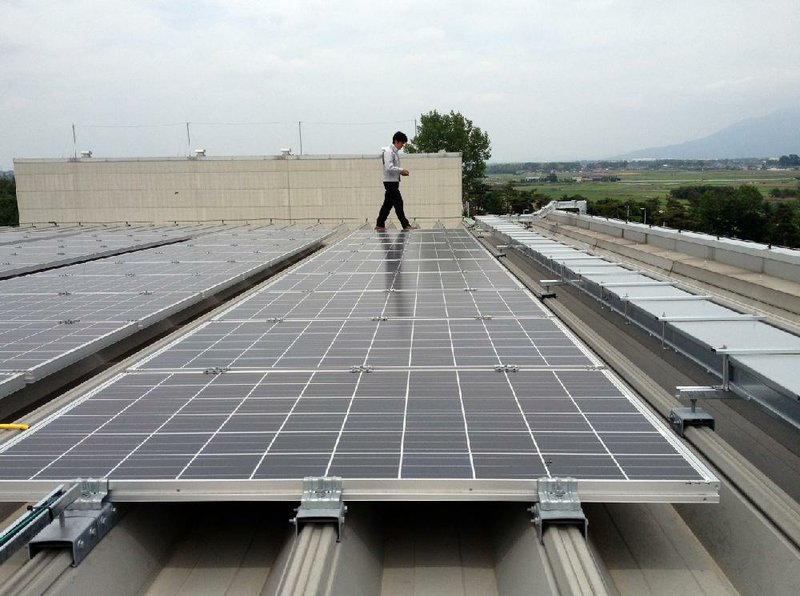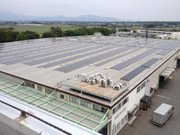TOKYO - Across Japan, technology firms and private investors are racing to install devices that until recently they had little interest in: solar panels.
Huge solar parks are popping up by the dozen, and companies are mounting panels atop warehouse and factory rooftops as part of a rapid build-up that one developer likened to an “explosion.”
The boom is striking in part because of how it was sparked by a little-noted government policy, implemented nearly a year ago, that suddenly guaranteed generous payments to anybody selling renewable energy, including solar power.
Because of that policy, known as a feed-in tariff, investors and analysts say Japan has become one of the world’s fastest-growing users of solar energy. The shift comes as this resource-poor country tries to find clean and homegrown alternatives to nuclear power. This year alone, Japan is forecast to install solar panels equal to the capacity of five to seven modern nuclear reactors.
Before the 2011 meltdowns at the Fukushima Daiichi plant, Japan had all but neglected renewable forms of energy.
Instead, the country emphasized atomic power, which it hoped would provide half of the nation’s energy by 2030. But the accident at Fukushima forced the shuttering of the country’s 50 operable reactors, only two of which have been restarted.
The remaining shutdowns could prove temporary, with Japanese Prime Minister Shinzo Abe pledging that any restarted reactors have been deemed safe. A majority of Japanese, though, remain opposed to atomic energy, and analysts say the solar takeoff highlights Japan’s appetite for other options.
There is a downside: Renewable energies are several times pricier than nuclear power or fossil fuels such as coal, oil and gas. The rising use of solar power means domestic energy bills will spike, potentially complicating Abe’s plan to jump-start Japan’s long-foundering economy.
Most consumers, so far, think that sacrifice is worthwhile, as they believe nuclear power carries hidden cleanup and compensation costs that only emerge after an accident. Fossil fuels, meanwhile, release harmful greenhouse gases and must be imported from Australia, Russia, Indonesia and the Middle East.
People in Japan tended to support clean-energy projects even before the nuclear disaster, but now there is “more interest in natural energy,” said Moriaki Yoshikawa. Yoshikawa is the secretary-general of an environmental nonprofit organization, Eco Plan Fukui, that has helped build five solar plants in a central region of Japan that hosts four nuclear plants.
This year, Japan’s total solar capacity - 7.4 gigawatts at the end of 2012 - is set to roughly double, adding between 6.1 and 9.4 gigawatts, Bloomberg New Energy Finance said in a recent report. Such growth would make Japan the second-fastest growing solar market behind China and leave it only behind Germany and Italy as measured by total installed capacity. A gigawatt can supply power to an estimated 250,000 homes.
The feed-in tariff is the legacy of Naoto Kan, Japan’s prime minister at the time of the Fukushima disaster, who decided after the meltdowns that atomic power was too dangerous for this earthquake prone-country.
Kan made a deal with the opposition party: He’d resign only after Japan’s parliament cooperated to pass several bills, including a renewable energy bill that established the tariff. Japan, Kan said, should boost renewable energies to account for about one fifth of Japan’s energy mix by the 2020s. At the moment, they account for about 10 percent, most of that coming from hydroelectric sources.
When it comes to energy, Kan said at the time, Japan needs to “start from scratch.”
The tariff, launched in July, obligates utility companies to buy electricity from renewable sources - solar, wind and geothermal, for example - at fixed prices. In most cases, utility companies are buying renewable-generated power from private individuals and companies.
European countries have used similar tariffs to spur clean-energy booms with the hope that widespread installation will drive innovations and lower prices for solar technology.
The feed-in tariff is fixed at an artificially high price, specifically to encourage start-up investment. The investors, in many cases, aren’t cutting-edge technology firms but instead include farmers, lumber companies and local governments. Once they install solar panels, they become small power-generation companies.
Under the terms of the tariff, they sell their renewable-generated energy to local utility companies at rates guaranteed for 20 years. The rates vary depending on the source, but solar is the most generous. When the tariff was first unveiled, sellers could get about 43 cents per kilowatt hour - about twice the rate in Germany and France.
Japan recently cut that rate by 10 percent, a change that applies to new projects, not those under way. But analysts say the reduction is unlikely to slow interest among solar developers.
“The government is sort of adding a bonus percentage to spark the market,” said Travis Woodward, a Tokyo-based Bloomberg New Energy Finance analyst. “The downside is definitely that [consumers] are paying for it. It’s great to introduce all this, but it’s going straight on your electricity bill.”
Even before the tariff was introduced, Japan had among the world’s highest energy costs. If 15 gigawatts of already-approved solar projects come online, those bills could increase 5 percent, Woodward said.
Among the projects under way, Lawson, a convenience store chain, is setting up panels on several thousand of its store rooftops. On a remote island that’s part of the Kyushu chain, developers are beginning work on a huge 400-megawatt solar park that will transmit energy to the regional utility company through underwater lines.
Much of the solar development comes from midsize projects, run by companies that operate large industrial buildings. Last December, one such company, SxL, an Osaka-based home builder, began blanketing the rooftop of its factory with Kyocera made solar panels - 5,166 in total. Engineers then installed transmission lines that in March began sending energy to Tokyo Electric Power Co., operator of the Fukushima plant.
“They take all of it,” said Takashi Kawasaki, the factory manager.
Information for this report was contributed by Yuki Oda of The Washington Post.
Business, Pages 23 on 06/10/2013

